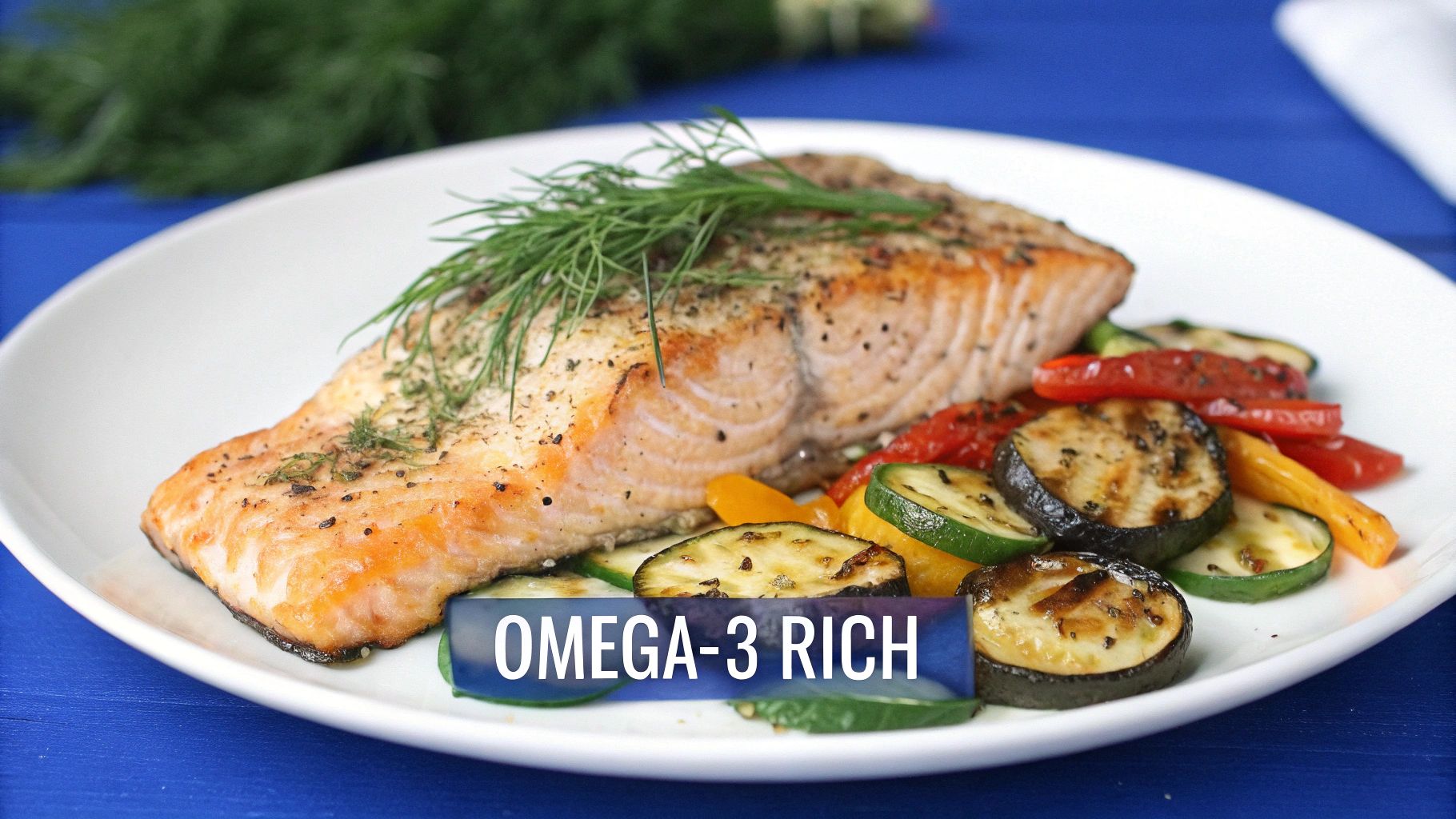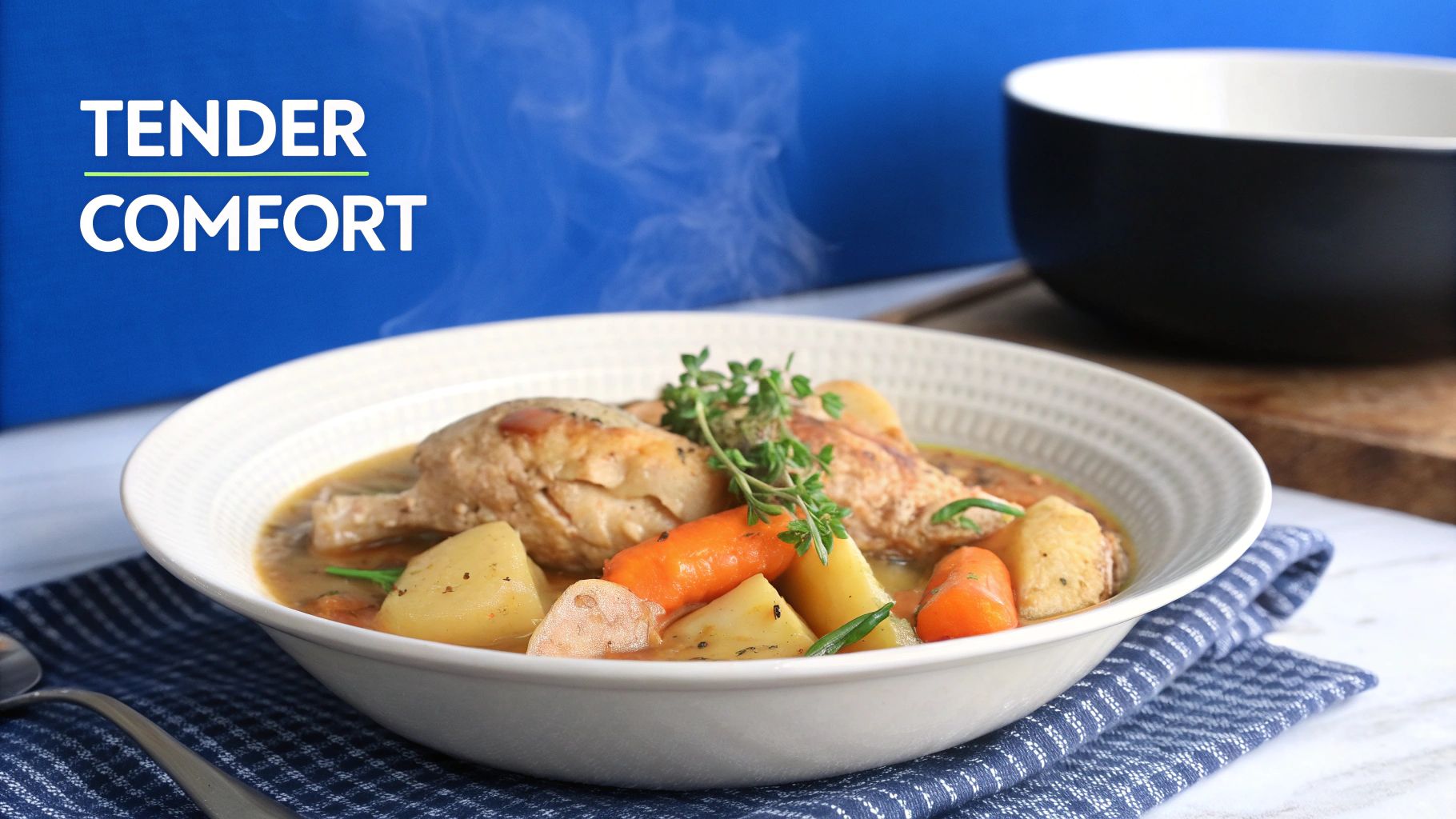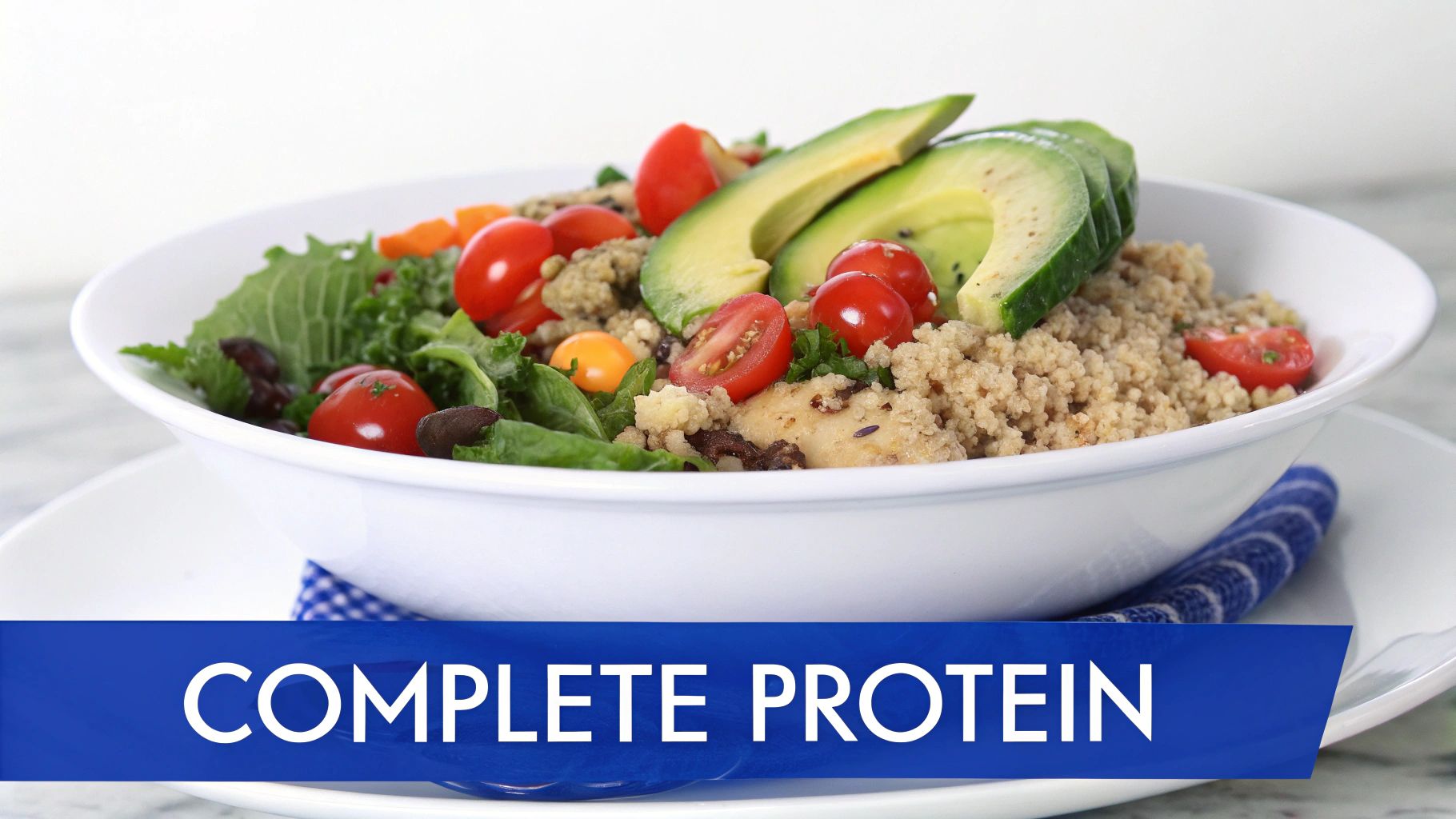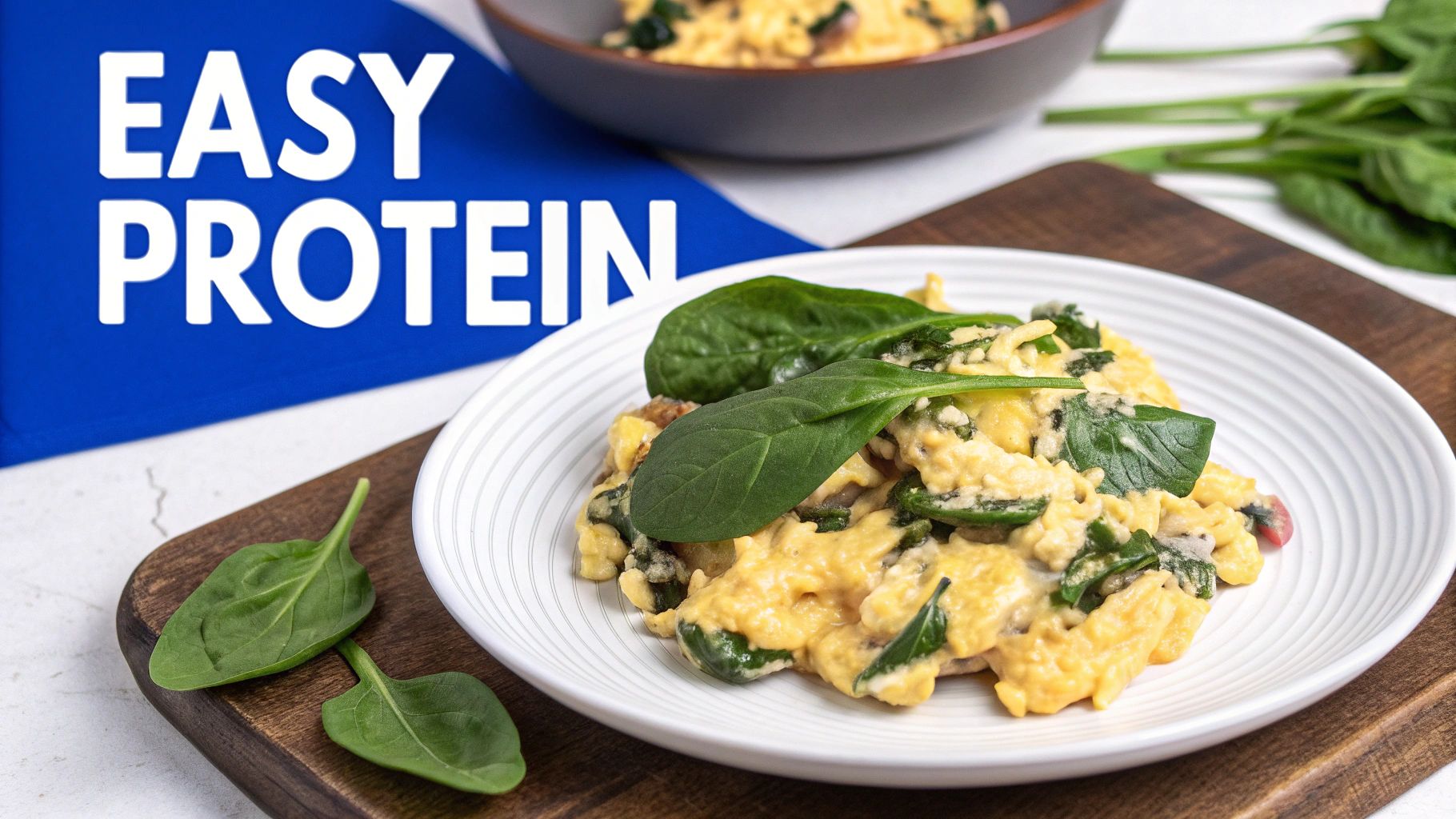As we or our loved ones age, nutritional needs shift dramatically. The right meals become more than just sustenance; they are a cornerstone of health, vitality, and independence. Factors like a declining appetite, chewing difficulties, medication side effects, and changing taste buds can often make preparing and eating meals a significant challenge. However, focusing on specific, nutrient-dense foods is crucial for combating age-related issues such as muscle loss, cognitive decline, and weakened bones.
This guide moves beyond generic advice to provide a curated list of practical and delicious healthy meals for elderly individuals. Each recipe and meal idea is specifically designed with senior-centric needs in mind. We will focus on:
- Soft textures that are easy to chew and swallow.
- High nutritional value to support overall wellness.
- Simple preparation methods for caregivers and seniors alike.
You will find actionable recipes, from Mediterranean Baked Salmon to a comforting Slow-Cooked Chicken Stew, ensuring every bite contributes to a healthier, more vibrant life. Let’s explore meals that are both nourishing and enjoyable.
1. Mediterranean Baked Salmon with Herbs
This simple yet elegant dish is a cornerstone of healthy meals for elderly individuals, championed by nutritional experts for its profound benefits on cognitive and physical health. It involves baking salmon, a fish rich in omega-3 fatty acids, with a flavorful coating of Mediterranean herbs like oregano, thyme, and rosemary. The meal is typically completed with roasted vegetables, creating a balanced, nutrient-dense plate.

This preparation method is popular in senior nutrition programs, including those recommended by the Mayo Clinic and featured in AARP's healthy aging meal plans. Its success lies in its simplicity and powerful nutritional profile. The high-quality protein in salmon is crucial for maintaining muscle mass and strength in seniors, while the omega-3s are renowned for supporting brain function and cardiovascular health.
Why It's a Top Choice for Senior Nutrition
The Mediterranean diet, from which this dish originates, is heavily endorsed by researchers like Dr. Walter Willett of Harvard and is a common feature in Blue Zones, regions where people live longer, healthier lives. Baking is a gentle cooking method that preserves nutrients and keeps the fish tender and easy to chew, an important consideration for older adults. The herbs not only add flavor without excess sodium but also offer antioxidant and anti-inflammatory benefits.
Actionable Tips for Perfect Preparation
To make this dish a success, follow these specific guidelines:
- Choose Wisely: Opt for wild-caught salmon when possible, as it generally has a more favorable ratio of omega-3 to omega-6 fatty acids.
- Enhance Flavor: Marinate the salmon for at least 30 minutes in olive oil, lemon juice, and herbs. This step helps tenderize the fish and deepens the flavor.
- Cooking Precision: Bake at a moderate temperature of 375°F (190°C). A typical 6-ounce fillet will cook in 12-15 minutes, ensuring it remains moist.
- Boost Nutrient Absorption: Serve with fresh lemon wedges. The vitamin C in the lemon helps the body absorb the iron from the salmon more effectively.
- Pair with Soft Vegetables: Accompany the salmon with roasted vegetables that are easy to digest, such as zucchini, bell peppers, and asparagus.
2. Slow-Cooked Chicken and Vegetable Stew
This hearty and comforting dish is a staple among healthy meals for elderly individuals, delivering comprehensive nutrition in a soft, warm format. It involves gently simmering chicken and a variety of vegetables in a savory broth over several hours. This slow-cooking process results in exceptionally tender meat and easily digestible vegetables, making it perfect for seniors who may have difficulty chewing or swallowing.

This one-pot meal is frequently featured by organizations focused on senior well-being, such as Meals on Wheels America, and is a common offering in geriatric care facilities and senior center meal programs. Its popularity stems from its ability to pack protein, vitamins, and minerals into a single, easy-to-consume serving. The broth also helps with hydration, a common concern for older adults.
Why It's a Top Choice for Senior Nutrition
Slow-cooking is an ideal preparation method that breaks down tough connective tissues in meat and softens fibrous vegetables, unlocking nutrients and making them more bioavailable. According to American Geriatrics Society nutrition guidelines, soft, nutrient-rich foods are essential for preventing malnutrition in older populations. The combination of lean protein from chicken supports muscle maintenance, while root vegetables like sweet potatoes and carrots provide essential beta-carotene for immune function and vision health.
Actionable Tips for Perfect Preparation
To maximize the benefits and flavor of this stew, consider these specific tips:
- Control Sodium: Always opt for a low-sodium chicken or vegetable broth to manage blood pressure. You can build flavor with herbs like thyme, rosemary, and bay leaves instead of salt.
- Add Vegetables in Stages: Add heartier root vegetables like potatoes and carrots at the beginning, and more delicate vegetables like peas or spinach in the last 30 minutes to prevent them from becoming mushy.
- Shred for Safety: Once cooked, remove the chicken, shred it with two forks, and return it to the pot. This eliminates choking hazards and makes the meal easier to eat.
- Boost with Beta-Carotene: Incorporate sweet potatoes and butternut squash. These are excellent sources of beta-carotene (a precursor to Vitamin A) and add a natural, gentle sweetness.
- Plan for Convenience: Prepare a large batch and freeze it in single-serving portions. This provides quick, healthy meals on days when cooking isn't feasible.
3. Quinoa Power Bowl with Soft Vegetables
This nutrient-dense bowl is a powerhouse of plant-based nutrition, making it one of the most versatile healthy meals for elderly individuals. It features fluffy quinoa, a complete protein, as its base and is topped with steamed soft vegetables, creamy avocado, and a light tahini dressing. The meal is specifically designed to provide all essential amino acids, high fiber for digestive regularity, and a wealth of antioxidants for robust immune support.

This type of meal is being successfully introduced in progressive senior living communities and is a staple in plant-based nutrition programs tailored for aging adults. Dietitians in cardiac rehabilitation centers also recommend it for its heart-healthy profile. Its popularity is driven by influential figures in plant-based nutrition like Dr. Michael Greger, author of "How Not to Age," who champion whole foods for longevity.
Why It's a Top Choice for Senior Nutrition
Quinoa is an exceptional grain for seniors because it contains all nine essential amino acids, making it a complete protein crucial for muscle maintenance. Its high fiber content aids digestion and helps regulate blood sugar levels, a key concern for many older adults. Steaming the vegetables ensures they are fork-tender and easy to chew and digest, while preserving vital nutrients that can be lost with other cooking methods. The healthy fats from avocado and tahini provide sustained energy and support brain health.
Actionable Tips for Perfect Preparation
To assemble a delicious and senior-friendly quinoa bowl, follow these specific guidelines:
- Remove Bitterness: Always rinse quinoa thoroughly in a fine-mesh sieve under cold water before cooking. This removes its natural coating, called saponin, which can taste bitter.
- Enhance Flavor: Cook the quinoa in low-sodium vegetable broth instead of water. This simple swap infuses the grain with a savory depth of flavor from the start.
- Ensure Soft Texture: Steam vegetables like broccoli, carrots, and sweet potatoes until they are easily pierced with a fork. This makes them much easier to chew and swallow.
- Boost Nutrient Absorption: Drizzle the finished bowl with a small amount of extra virgin olive oil or tahini dressing. Healthy fats are essential for absorbing fat-soluble vitamins like A, D, E, and K present in the vegetables.
- Add Freshness: Garnish with fresh, soft herbs like parsley or cilantro. These add bright flavor and additional vitamins without relying on salt.
4. Soft Scrambled Eggs with Spinach and Cheese
This classic comfort food is a powerhouse when it comes to healthy meals for elderly individuals, offering a soft texture that's easy to chew and swallow. The combination of creamy, protein-rich scrambled eggs with nutrient-dense spinach and calcium-fortified cheese creates a simple, satisfying meal. It’s perfect for seniors needing easily digestible protein, which is essential for maintaining muscle mass, supporting bone health, and aiding cognitive function.

This dish is a staple in many senior care settings, from assisted living breakfast menus to hospital geriatric nutrition protocols. Its versatility makes it suitable for any time of day. The high-quality protein in eggs provides essential amino acids, while spinach adds vital nutrients like iron, vitamin K, and folate. The addition of cheese boosts the calcium and protein content, further supporting bone density.
Why It's a Top Choice for Senior Nutrition
Eggs are a nutritional goldmine, promoted by organizations like the American Egg Board for senior wellness. Dietitians in geriatric care often recommend this meal for its gentle nature on the digestive system. Furthermore, its soft consistency makes it an ideal choice for individuals with chewing difficulties or dysphagia, a recommendation often made by speech-language pathologists. This meal delivers a significant nutritional punch without requiring much effort to eat.
Actionable Tips for Perfect Preparation
To ensure this dish is both delicious and nutritionally optimal, consider these tips:
- Gentle Cooking: Cook the eggs over low heat, stirring frequently. This prevents them from becoming tough and creates a creamy, soft texture.
- Time the Spinach: Add fresh spinach leaves in the last minute of cooking. The residual heat will wilt them perfectly without them becoming soggy or losing nutrients.
- Enhance Softness: Whisk in a tablespoon of milk or a small amount of cream before cooking. This adds moisture and contributes to a fluffier, more tender result.
- Choose Mild Cheese: Opt for mild, meltable cheeses like cheddar, Swiss, or Monterey Jack. A small amount adds flavor and calcium without overwhelming the dish.
- Serve Thoughtfully: Pair with a slice of soft, whole-grain toast, cut into small, manageable pieces for easy handling and chewing.
5. Lentil and Sweet Potato Curry
This warming, plant-based dish is a powerhouse of nutrition and an excellent choice for healthy meals for elderly individuals. The curry combines protein-rich lentils with beta-carotene-packed sweet potatoes in a mild, anti-inflammatory sauce. It's specifically designed to be gentle on the digestive system while delivering substantial health benefits.
This meal is a staple in multicultural senior centers and is frequently featured in plant-based nutrition programs for aging adults. Its popularity stems from its comforting nature and its ability to provide complete nutrition in one bowl. The combination of plant protein and fiber supports muscle maintenance and digestive regularity, while the warming spices like turmeric and ginger offer anti-inflammatory properties that can help soothe achy joints.
Why It's a Top Choice for Senior Nutrition
Integrative medicine experts like Dr. Andrew Weil often recommend meals rich in anti-inflammatory spices and plant-based fiber. This curry fits that profile perfectly. The soft texture of the cooked lentils and sweet potatoes makes it easy to chew and swallow, addressing common challenges for older adults. Furthermore, the vibrant orange of the sweet potatoes indicates high levels of beta-carotene, an antioxidant that the body converts to Vitamin A, which is essential for vision and immune health.
Actionable Tips for Perfect Preparation
To ensure this curry is both delicious and senior-friendly, consider these specific tips:
- Soften the Spice: Begin with mild spices like turmeric, cumin, and a hint of ginger. You can always add more to suit individual taste preferences, but starting mild prevents the dish from being overwhelming.
- Use Red Lentils: Opt for red lentils as they cook faster and break down more completely, resulting in a softer, creamier texture that is easier to digest.
- Add Healthy Fats: Stir in full-fat coconut milk towards the end of cooking. This adds a rich creaminess, healthy fats for brain health, and helps to mellow the spices.
- Create a Complete Meal: Serve the curry over a bed of fluffy basmati rice or with a side of soft whole-wheat naan bread to ensure a balanced intake of carbohydrates.
- Garnish for a Nutrient Boost: Top the finished dish with a sprinkle of fresh cilantro. It adds a burst of freshness, flavor, and extra vitamins.
6. Bone Broth Vegetable Soup with Soft Noodles
This comforting and deeply nourishing soup is a standout choice among healthy meals for elderly individuals. It combines the ancient tradition of bone broth with soft, easily digestible vegetables and noodles, creating a hydrating and nutrient-rich meal. The foundation is a slow-simmered bone broth, prized for its high concentration of collagen, gelatin, and easily absorbed minerals like calcium and magnesium.
This type of soup is a staple in rehabilitative care, often seen in hospital geriatric wards and recommended by naturopathic doctors. Its popularity, boosted by health advocates like Dr. Kellyann Petrucci and the ancestral health movement, stems from its gentle nature and potent nutritional profile. The broth supports joint health and gut integrity, while the soft components make it easy to eat, even for those with dental issues or a low appetite.
Why It's a Top Choice for Senior Nutrition
Bone broth is celebrated for its healing properties, providing a rich source of amino acids that support tissue repair and reduce inflammation. For seniors, this can translate to better joint mobility and a stronger immune system. The soup format ensures hydration, a common concern among the elderly, while delivering vitamins and minerals in a warm, soothing form. It’s a complete, one-pot meal that is both comforting and fundamentally restorative.
Actionable Tips for Perfect Preparation
To maximize the benefits and flavor of this soup, consider these specific tips:
- Control Sodium: Use a pre-made low-sodium bone broth or make your own to have full control over the salt content. Simmering bones with a splash of apple cider vinegar can help extract more minerals.
- Layer the Vegetables: Add vegetables according to their cooking time. Start with harder vegetables like carrots and celery, then add softer ones like peas, corn, or finely chopped spinach near the end to prevent them from becoming mushy.
- Choose Appropriate Noodles: Opt for small pasta shapes like ditalini or orzo, which are easy to manage. Alternatively, break longer noodles like spaghetti into smaller, bite-sized pieces before cooking.
- Add Protein: Boost the protein content by adding shredded cooked chicken or soft lentils to make it a more substantial meal.
- Freeze for Convenience: Prepare a large batch and freeze it in single-serving portions. This provides a quick, healthy meal option for days when cooking feels like too much effort.
7. Baked Cod with Mashed Cauliflower
This gentle meal is a fantastic choice when considering healthy meals for elderly individuals, particularly those needing soft textures and lower carbohydrates. The dish pairs delicate, flaky baked cod with creamy mashed cauliflower, a smart and nutritious substitute for traditional mashed potatoes. It provides high-quality, easily digestible protein while helping to manage blood sugar levels, making it a staple in specialized senior diets.

This meal is frequently recommended within senior health programs focused on diabetes management and heart health. Its inclusion in guidelines from the American Heart Association and its popularity among low-carb diet advocates like Dr. Eric Westman highlight its therapeutic benefits. The soft consistency of both the fish and cauliflower makes it ideal for seniors with dental issues or difficulty chewing.
Why It's a Top Choice for Senior Nutrition
Cod is a lean source of protein and an excellent source of vitamin B12, which is vital for nerve function and energy production in older adults. Swapping potatoes for cauliflower significantly reduces the meal's glycemic load, aiding in stable blood sugar control. This substitution also boosts the intake of fiber and anti-inflammatory compounds found in cruciferous vegetables. Baking the cod preserves its delicate texture and nutrients without adding unnecessary fats.
Actionable Tips for Perfect Preparation
To ensure this dish is both delicious and nutritionally optimized, follow these tips:
- Choose Wisely: Select thick, center-cut cod fillets for even cooking and a meatier texture. Both fresh and frozen options work well.
- Enhance Flavor: Season the cod generously with mild herbs like dill or parsley and a little lemon pepper. These flavors complement the fish without relying on salt.
- Cooking Precision: Bake the cod on a lightly oiled baking sheet at 400°F (200°C) for just 12-15 minutes, or until it flakes easily with a fork. Overcooking will make it dry.
- Boost Nutrient Absorption: Serve with a fresh squeeze of lemon juice. The vitamin C not only brightens the flavor but also helps the body absorb the iron from the meal.
- Create Creamy Cauliflower: Steam the cauliflower until it is very tender before mashing. For extra richness and a smoother texture, blend it with a touch of cream cheese or Greek yogurt.
8. Overnight Oats with Berries and Nuts
This no-cook breakfast is a game-changer when it comes to convenient and healthy meals for elderly individuals. The preparation involves soaking rolled oats overnight in a liquid like milk or yogurt, which softens them into a creamy, porridge-like consistency. Topped with antioxidant-rich berries and finely chopped nuts, this make-ahead meal provides sustained energy, fiber for digestive health, and crucial nutrients in a soft, easy-to-eat format.
This meal is a staple in Scandinavian wellness traditions and has been widely adopted by geriatric nutritionists and meal prep programs for aging adults. Its popularity stems from its simplicity and impressive nutritional benefits. The soluble fiber in oats, particularly beta-glucan, helps manage cholesterol levels and supports stable blood sugar, while the combination of berries and nuts offers a powerful dose of vitamins, minerals, and healthy fats.
Why It's a Top Choice for Senior Nutrition
Geriatric dietitians frequently recommend overnight oats because they require no morning effort, which is ideal for seniors who may have low energy or limited mobility. The soaking process makes the oats exceptionally easy to digest and chew, addressing common dental or swallowing difficulties. The meal is also highly customizable, allowing for adjustments based on dietary needs, such as using fortified milk for extra calcium and vitamin D or adding protein powder to support muscle maintenance.
Actionable Tips for Perfect Preparation
To create a delicious and nutritionally balanced bowl of overnight oats, follow these tips:
- Choose the Right Oats: Use old-fashioned rolled oats for the best texture. They absorb liquid well without becoming mushy like instant oats can.
- Boost with Seeds: Mix in a tablespoon of chia seeds or ground flaxseeds before soaking. This adds a significant amount of fiber and plant-based omega-3 fatty acids.
- Mind the Sugar: Opt for fresh or frozen berries instead of sweetened or dried varieties to control sugar intake. A small amount of maple syrup or honey can be used if needed.
- Ensure Safety: Finely chop or grind nuts and seeds to prevent them from being a choking hazard. Nut butters are also an excellent, safer alternative.
- Adjust Consistency: If the mixture is too thick in the morning, simply stir in a splash of milk or water until it reaches the desired consistency.
Healthy Meal Options Comparison for Elderly
| Dish | Implementation Complexity 🔄 | Resource Requirements ⚡ | Expected Outcomes 📊 | Ideal Use Cases 💡 | Key Advantages ⭐ |
|---|---|---|---|---|---|
| Mediterranean Baked Salmon with Herbs | Medium (requires timing control) | Moderate (fresh salmon, herbs) | High-quality protein, omega-3 for heart & brain health | Elderly needing muscle & cognitive support | Easy one-pan cooking, anti-inflammatory herbs, eye-appealing |
| Slow-Cooked Chicken and Vegetable Stew | High (long cooking time) | Moderate (bone broth, vegetables) | Tender protein, immune & bone health support | Chewing difficulties, batch cooking | Soft textures, cost-effective, customizable |
| Quinoa Power Bowl with Soft Vegetables | Medium (quinoa rinsing, steaming) | Low to moderate (quinoa, veggies) | Complete plant protein, fiber for digestion | Plant-based diets, digestive health | Gluten-free, colorful, sustained energy |
| Soft Scrambled Eggs with Spinach and Cheese | Low (quick, simple cooking) | Low (eggs, spinach, cheese) | Easily absorbed complete protein, brain & bone nutrients | Quick meals, dysphagia-friendly | Fast prep, creamy texture, familiar comfort food |
| Lentil and Sweet Potato Curry | Medium (soaking & spice control) | Low (lentils, sweet potatoes) | Plant protein, anti-inflammatory, digestive health | Vegetarian/vegan, inflammation support | Budget-friendly, batch prep, warming spices |
| Bone Broth Vegetable Soup with Soft Noodles | Medium to High (long broth prep) | Moderate (bone broth, noodles) | Collagen for joints, hydrating minerals | Joint health, hydration, illness comfort | Easily digestible, customizable, nourishing |
| Baked Cod with Mashed Cauliflower | Medium (baking, mashing) | Moderate (cod, cauliflower) | Lean protein, blood sugar management | Low-carb, sensitive teeth/gums | Quick cooking, mild flavors, low calories |
| Overnight Oats with Berries and Nuts | Low (no cooking, prep ahead) | Low (oats, berries, nuts) | Sustained energy, fiber, antioxidants | Limited mobility, easy breakfast | No-cook, customizable, heart-healthy |
Making Mealtime Meaningful and Easy
Transitioning to a diet that supports healthy aging doesn't have to be a monumental task. As we've explored, the key lies in embracing simple, nutrient-dense ingredients and gentle cooking methods that cater to the unique needs of older adults. The recipes shared in this article, from Mediterranean Baked Salmon to a comforting Bone Broth Vegetable Soup, all center on a few core principles: soft textures, high-quality protein, essential vitamins, and fantastic flavor. These aren't just meal ideas; they are blueprints for creating nourishing experiences that support physical health and bring joy to the daily routine.
The true value of focusing on healthy meals for elderly individuals extends far beyond the plate. It's about preserving dignity, enhancing quality of life, and providing comfort. When food is easy to chew, simple to digest, and packed with the right nutrients, it can significantly impact energy levels, cognitive function, and immune resilience.
Key Takeaways for Senior Nutrition
Let's distill the most crucial insights from our exploration of senior-friendly meals:
- Prioritize Soft Textures: Foods like slow-cooked stews, soft scrambled eggs, and mashed cauliflower are easier and safer to chew and swallow, reducing mealtime frustration.
- Focus on Nutrient Density: Every calorie should count. Prioritize lean proteins (fish, chicken, lentils), colorful vegetables, healthy fats (olive oil, avocado), and complex carbohydrates (quinoa, oats) to support overall wellness.
- Hydration is Crucial: Many seniors struggle with hydration. Soups, stews, and smoothies are excellent ways to incorporate more liquids into the diet naturally.
- Flavor without Excess Sodium: Use herbs, spices, lemon juice, and bone broth to build rich, satisfying flavors without relying on high levels of salt, which can be detrimental for heart and kidney health.
Actionable Next Steps for Caregivers and Seniors
Mastering the art of preparing healthy meals for elderly loved ones is a journey of small, consistent steps. To begin, choose just one or two recipes from this list to try this week. See which flavors and textures are most enjoyed. Involve the senior in the meal planning process if possible, asking about their favorite foods from the past that could be adapted for their current needs.
Another powerful step is to embrace meal prepping. Making a large batch of Lentil and Sweet Potato Curry or a pot of chicken stew on the weekend can provide several easy, ready-to-heat meals throughout the week. This simple strategy reduces daily cooking stress and ensures a nutritious option is always available, even on busy days. Remember, the goal is progress, not perfection. By gradually introducing these meals, you can create a positive and sustainable shift in dietary habits, profoundly impacting well-being and independence.
We understand that providing consistent, nutritious meals can be a significant challenge for busy families. If you need support ensuring your loved one receives delicious and appropriate healthy meals for elderly nutritional needs, NJ Caregiving is here to help. Our compassionate in-home caregivers specialize in meal planning and preparation, bringing peace of mind to your family and joy to your loved one's table. Visit NJ Caregiving to learn how we can support your family's journey.



